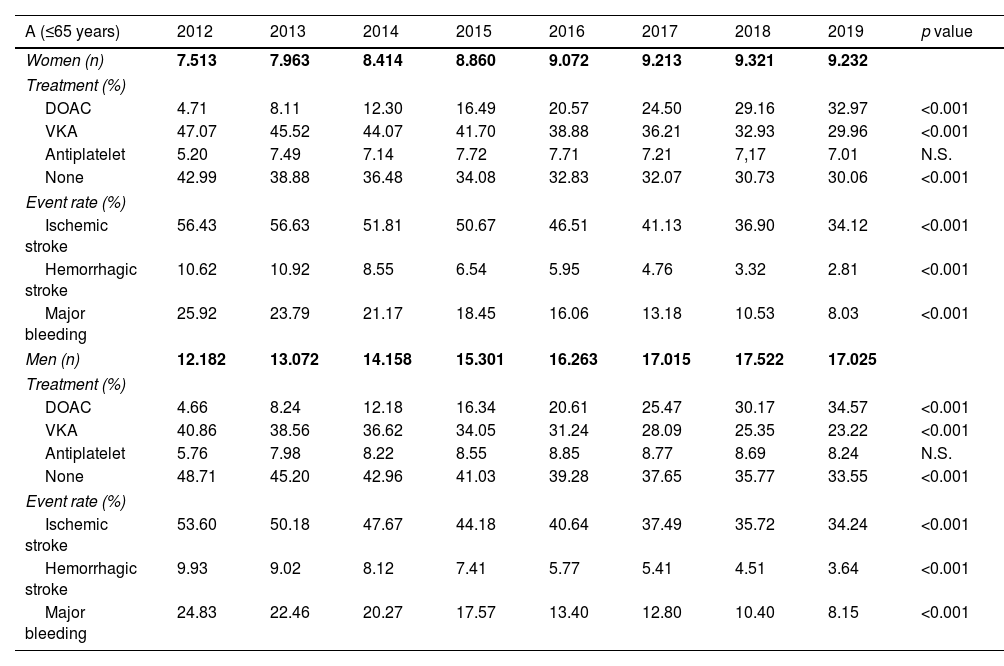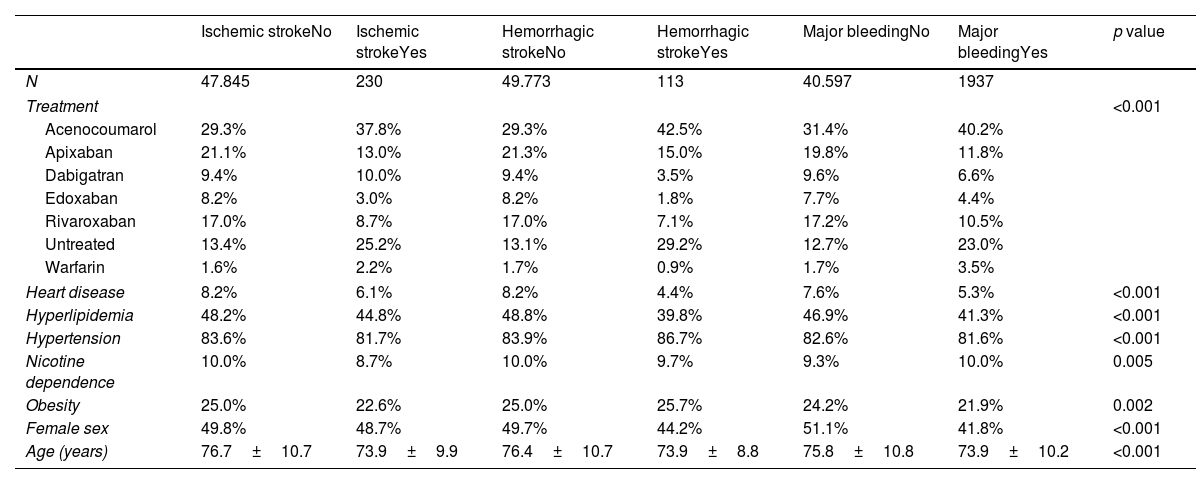The introduction of direct-acting oral anticoagulants (DOACs) has shown to decrease atrial fibrillation (AF)-related stroke and bleeding rates in clinical studies, but there is no certain evidence about their effects at the population level. Our aim was to assess changes in AF-related stroke and major bleeding rates between 2012 and 2019 in Andalusia (Spain), and the association between DOACs use and events rates at the population level.
MethodsAll patients with an AF diagnosis from 2012 to 2019 were identified using the Andalusian Health Population Base, that provides clinical information on all Andalusian people. Annual ischemic and hemorrhagic stroke, major bleeding rates, and used antithrombotic treatments were determined. Marginal hazard ratios (HR) were calculated for each treatment.
ResultsA total of 95,085 patients with an AF diagnosis were identified. Mean age was 76.1±10.2 years (49.7% women). An increase in the use of DOACs was observed throughout the study period in both males and females (p<0.001). The annual rate of ischemic stroke decreased by one third, while that of hemorrhagic stroke and major bleeding decreased 2–3-fold from 2012 to 2019. Marginal HR was lower than 0.50 for DOACs compared to VKA for all ischemic or hemorrhagic events.
ConclusionsIn this contemporary population-based study using clinical and administrative databases in Andalusia, a significant reduction in the incidence of AF-related ischemic and hemorrhagic stroke and major bleeding was observed between 2012 and 2019. The increased use of DOACs seems to be associated with this reduction.
La introducción de los anticoagulantes orales de acción directa (ACOD) ha demostrado disminuir las tasas de accidentes cerebrovasculares y hemorragias relacionados con fibrilación auricular (FA) en estudios clínicos, pero no hay tanta evidencia sobre sus efectos a nivel poblacional. Nuestro objetivo fue evaluar los cambios en la incidencia de ictus y hemorragias mayores relacionados con FA entre 2012 y 2019 en Andalucía (España), y estudiar la asociación entre el uso de ACOD y estos eventos a nivel poblacional.
MétodosSe incluyeron pacientes con diagnóstico de FA entre los años 2012 y 2019 en la Base de Población Sanitaria de Andalucía, que proporciona información clínica de todos los andaluces. Se determinaron los accidentes cerebrovasculares isquémicos y hemorrágicos anuales, las tasas de sangrado mayor y los tratamientos antitrombóticos utilizados. Se estimaron los hazard ratio para cada tratamiento.
ResultadosSe identificaron un total de 95.085 pacientes con diagnóstico de FA. La edad media fue de 76,1±10,2 años (49,7% mujeres). Se observó un aumento en el uso de ACOD a lo largo del período de estudio, tanto en varones como en mujeres (p<0,001). La tasa anual de ictus isquémico disminuyó en un tercio, mientras que la de ictus hemorrágico y hemorragia mayor se redujo de 2 a 3 veces entre 2012 y 2019. Los hazard ratio fueron inferiores a 0,50 para los ACOD en comparación con los antivitamina K para todos los eventos isquémicos o hemorrágicos.
ConclusionesEn este estudio poblacional contemporáneo, se observó, utilizando bases de datos clínicas y administrativas de Andalucía, una reducción significativa en la incidencia de ictus isquémico y hemorrágico, y hemorragia mayor relacionados con FA entre los años 2012 y 2019. El mayor uso de ACOD parece estar asociado con esta reducción.












